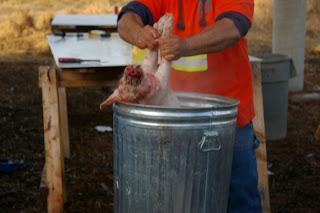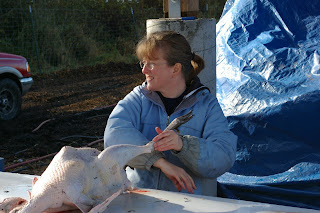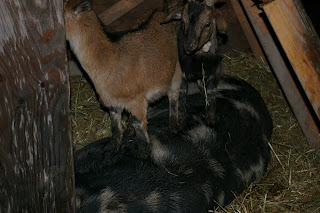WARNING: THIS ENTRY CONTAINS GRAPHIC SLAUGHTER PICTURESI've been selling an increasing number of my animals live, to people who want to prepare them themselves. Each culture has its own traditions and preferences, and each one its favorite food.
Soni and Sime have been great customers of mine. They prefer a small pig, what I call a weaner pig, usually having a live weight of 40 to 50lbs.
I'm ok with people eating animals; I eat them myself, and that's why I started farming -- to make sure the animals I eat have the best life possible while there here.
For pigs, I prefer they be shot. It's a clean and quick, humane end. There are many cultures that have a specific way they kill the pig, and while I try to be tolerant of other cultures, I've found that a bullet is the way that I prefer, and for animals killed on my farm that's what I require.
After shooting, the next step is to cut the arteries at the top of the heart while it's still beating. Most of the blood is out of the pig in a few seconds. After that, it looks like this.
 Pork skin is delicious.
Pork skin is delicious.Pork rind (southern USA) or pork scratchings (UK) or Pork crackle (Australia) or in spanish They will be spit-roasting these pigs whole. The skin of the pig is a prized bit -- it's delicious. In the south part of the USA, they'll call it pork cracklins or pork rind. In Spanish it's chicharrones. Whatever language, many cultures all over the world love it, and Tongans are no exceptions.
 There's a propane heater underneath the garbage can. Both of these guys are immensely strong; they can easily handle a 50lb pig at arms length. I'm not sure I could. They dip it in and then pull it out and quickly rub off the outer layer of skin and hair. It comes off pretty easily.
There's a propane heater underneath the garbage can. Both of these guys are immensely strong; they can easily handle a 50lb pig at arms length. I'm not sure I could. They dip it in and then pull it out and quickly rub off the outer layer of skin and hair. It comes off pretty easily.

All pigs end up white after they've been scraped, no matter what color they started with. This particular animal had a moire pattern on its skin. The line there is where the outer layer of skin has been removed. These fellows dip the pig, and then pull it out and lay it down, and rub off the skin with their fingers. the fellow on the left is removing the toenails from the pig. they don't cut the feet off -- the whole pig is spit-roasted.

The head is a favorite part of the roasted pig, but there's a lot of hair on the head. It takes a while to scrape it all off. There are a lot of nooks and crannies that have to be cleaned.
 There are still a few hairs here and there -- the ears are particularly problematic. So a propane torch is used to singe off the remaining hair.
There are still a few hairs here and there -- the ears are particularly problematic. So a propane torch is used to singe off the remaining hair.

The torch quicky removes the hair. They run the torch over one side, flip the pig, and finish the other side. They are very careful to get every single hair.
Now they are ready to gut it. The digestive tract of most mammals is only anchored at the mouth and anus. They reach in to the wound used to bleed the pig and cut out the vocal cords, effectively severing the connection at the head.

Now you carefully cut around the anus. The goal here is to cut the anus free, but not to cut the colon it is attached to. He makes a small square cut around the anus and poking his finger in carefully works it free, cutting as he goes.

The digestive system is pretty much free, but the opening at the anus isn't large enough to allow the liver or other large organs to come out. So an incision is now made in the belly -- but a small incison. They're going to spit-roast the animal, so they want the ribcage to be whole so that it'll be easier to spit.

Working his hand in carefully, he pulls the colon out the incision, and then the rest of the organs. The heart and lungs and kidneys also come out this same hole.

Once the organs are out, they sort through them and cut out the ones they want; in this case, the heart, liver, kidneys and lungs.


This pig is now ready to go for spit roasting. Soni and Sime -- happy holidays

If you'd like to learn how to roast a pig from here, there's a great website that goes into detail. You'll find it here
http://cuban-christmas.com/pigroast.htmlTotal elapsed time from shooting the pig to finished pig: about 45 minutes.


 Notice in those pictures that the skin appears thinner on the broad breasted bird. This is a function of the amount of fat in the skin. the veins in the broad breasted bird are much more visible.
Notice in those pictures that the skin appears thinner on the broad breasted bird. This is a function of the amount of fat in the skin. the veins in the broad breasted bird are much more visible.  The top organ is the gizzard. My turkeys gizzard is considerably larger and covered with a layer of fat, showing that the bird used its gizzard and had a good life. The broad breasted gizzard is smaller, less than half the size, and has no fat to speak of.
The top organ is the gizzard. My turkeys gizzard is considerably larger and covered with a layer of fat, showing that the bird used its gizzard and had a good life. The broad breasted gizzard is smaller, less than half the size, and has no fat to speak of. 














 The tractor is stuck a few hundred feet from the road and it weighs 10,0000lbs and it's on soft mud. So I don't really want to jack it up or bring out heavy equipment to get it out.
The tractor is stuck a few hundred feet from the road and it weighs 10,0000lbs and it's on soft mud. So I don't really want to jack it up or bring out heavy equipment to get it out. 








































